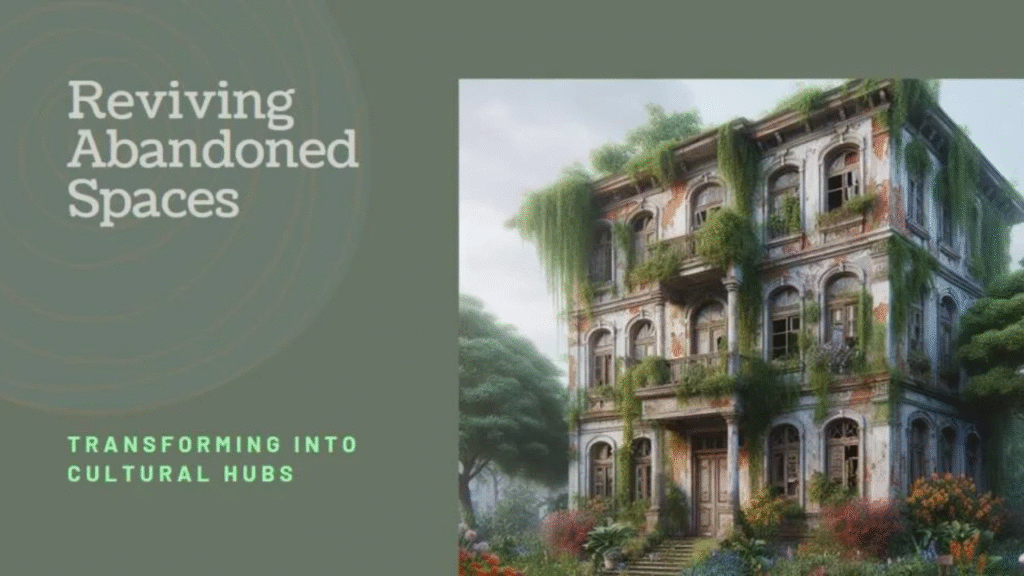
In cities around the world, abandoned urban lots—once symbols of decay—are being transformed into productive community spaces that foster inclusion, resilience, and sustainability. These vacant plots, often seen as liabilities, hold immense potential when reimagined through thoughtful design and grassroots involvement. Whether turned into gardens, learning centers, markets, or green play areas, they are reshaping urban life by reconnecting people to place, purpose, and each other.
Overview Table: Transforming Abandoned Urban Lots
| Transformation Type | Community Impact |
|---|---|
| Urban Gardens | Improve food access and local ecology |
| Pocket Parks | Create safe, recreational areas |
| Outdoor Classrooms | Enable learning in under-resourced areas |
| Pop-Up Markets | Stimulate local entrepreneurship |
| Art & Culture Spaces | Celebrate identity and social expression |
| Green Infrastructure | Reduce pollution and manage stormwater |
1. Why Abandoned Lots Matter in Urban Revitalization
Abandoned lots often arise from economic downturns, migration, or disinvestment. Left unused, they attract illegal dumping, crime, and pests—lowering neighborhood morale and property values. However, these lots are blank canvases in dense urban areas where space is scarce.
Redesigning them supports:
- Community pride and ownership
- Social cohesion through shared spaces
- Environmental healing via green interventions
- Microeconomic development and job creation
2. Community-Led Design: The Key to Success
The transformation process must be participatory, ensuring the final space meets real community needs.
Engagement Strategies Include:
- Local workshops and mapping sessions
- Input from youth, seniors, and underrepresented groups
- Partnering with schools, nonprofits, and urban planners
This bottom-up approach leads to more inclusive, culturally relevant, and sustainable results.
3. Types of Productive Uses for Abandoned Lots
| Space Type | Features | Primary Benefits |
|---|---|---|
| Community Gardens | Raised beds, compost bins, tool sheds | Improves food security and nutrition |
| Pocket Parks | Benches, trees, play features | Supports mental health and recreation |
| Urban Farms | Vertical systems, aquaponics, greenhouses | Creates jobs and local food distribution |
| Cultural Plazas | Murals, open-air stages, storytelling circles | Promotes arts, heritage, and intergenerational links |
| Pop-up Shops | Booths, kiosks, food trucks | Empowers small businesses and local artists |
| Learning Hubs | Outdoor classrooms, STEM installations, Wi-Fi zones | Enhances informal education access |
4. Steps to Redesign an Abandoned Lot
Step 1: Site Assessment
Analyze soil conditions, sunlight, drainage, and existing hazards. Evaluate land ownership and zoning restrictions.
Step 2: Community Needs Analysis
Conduct surveys and meetings to identify what residents want—be it green space, markets, safety, or education.
Step 3: Design & Planning
Work with landscape architects and urban designers to co-create a design. Emphasize modular and low-cost materials.
Step 4: Funding & Permits
Secure funding from local governments, NGOs, or crowdfunding platforms. Obtain relevant construction or usage permits.
Step 5: Construction & Stewardship
Build in phases with volunteer support. Assign long-term maintenance roles to community groups or schools.
5. Sustainability and Resilience Features
Redesigned lots can serve ecological functions too:
- Rain Gardens: Capture and filter stormwater runoff
- Native Plantings: Reduce maintenance and support biodiversity
- Solar Lighting: Increases safety and reduces energy bills
- Composting Stations: Close the local food-waste loop
- Recycled Materials: Cost-effective and environmentally friendly
By integrating green infrastructure, these lots become not just beautiful but functional urban assets.
6. Challenges and How to Overcome Them
| Challenge | Solution |
|---|---|
| Ownership Disputes | Work with land banks or municipalities for temporary leases |
| Vandalism or Misuse | Involve locals in maintenance and surveillance |
| Limited Funding | Apply for grants, engage volunteers, or use low-cost design |
| Soil Contamination | Use raised beds or phytoremediation techniques |
| Community Resistance | Host listening sessions and co-design events to build trust |
A flexible, patient approach with consistent communication is key to overcoming these barriers.
7. Benefits of Community-Driven Lot Redesign
| Domain | Impact |
|---|---|
| Social | Builds networks, reduces crime, empowers residents |
| Economic | Creates markets, jobs, and property value uplift |
| Environmental | Restores biodiversity, improves air and water quality |
| Educational | Provides experiential learning opportunities |
| Cultural | Honors local identity and collective memory |
These benefits often multiply over time, catalyzing broader neighborhood revitalization.
3 Best One-Line FAQs
1. Can abandoned lots really reduce crime and improve community safety?
Yes—activating space increases foot traffic and social presence, which deters illicit activity.
2. Who typically funds urban lot transformation projects?
Funding can come from local governments, nonprofits, private donors, or community crowdfunding.
3. How long does it take to transform an abandoned lot?
Depending on size and complexity, it can take from 2 months to 2 years, including community input and permitting.
Conclusion
Redesigning abandoned urban lots into productive community spaces is a win-win for neighborhoods. It transforms decay into dignity, isolation into interaction, and waste into worth. These spaces not only meet immediate needs for recreation, food, or culture—they also symbolize hope and collective power. As more cities embrace this grassroots approach, forgotten plots of land are becoming the foundation for healthier, happier, and more equitable communities.

